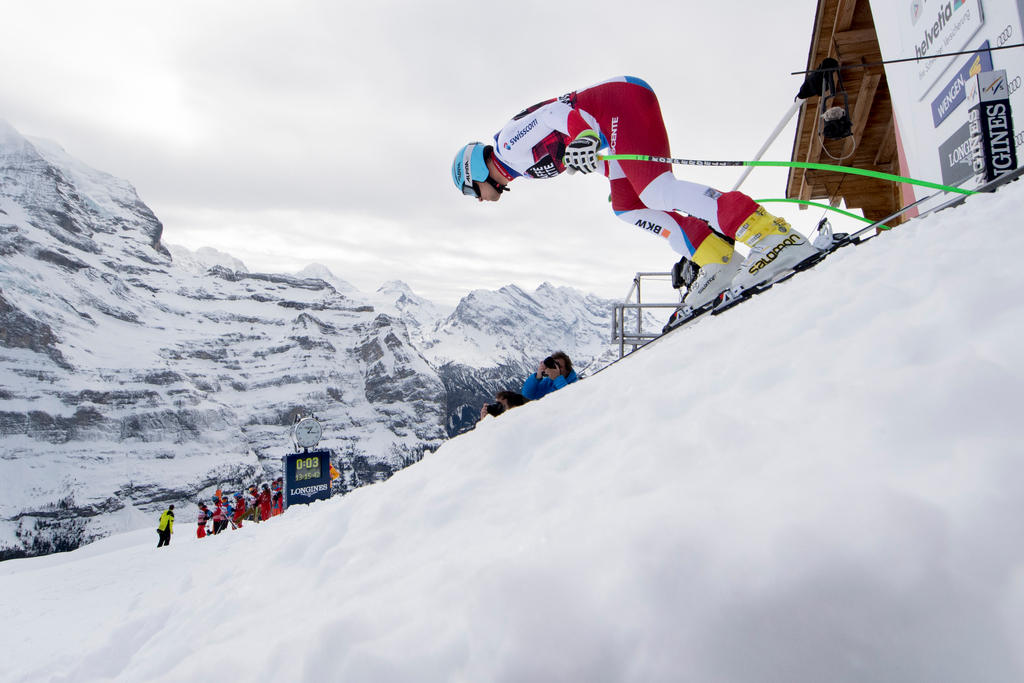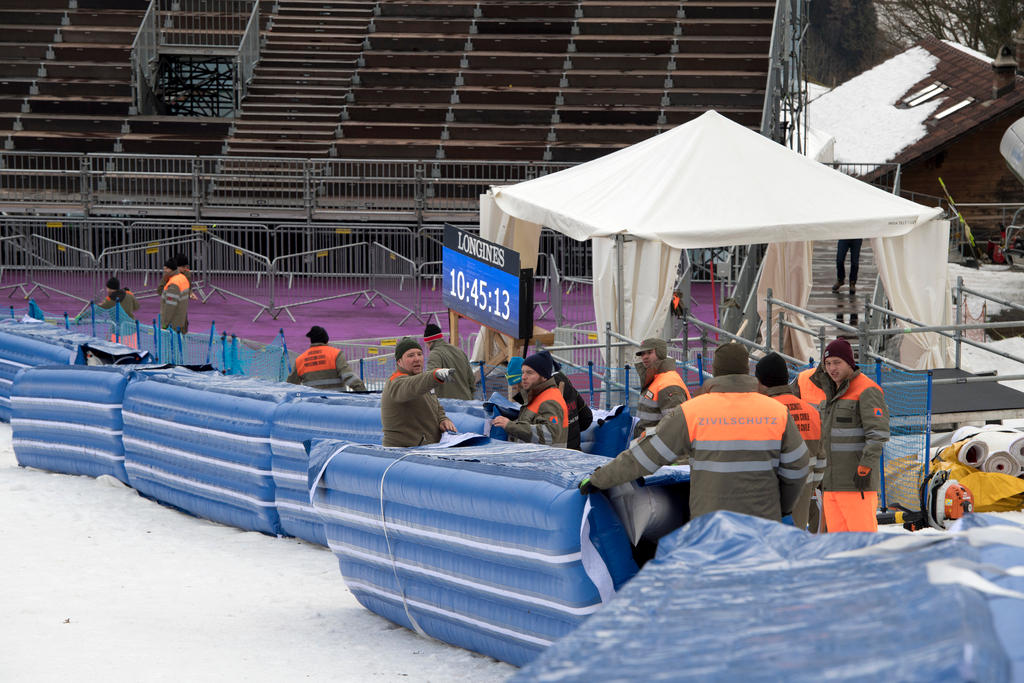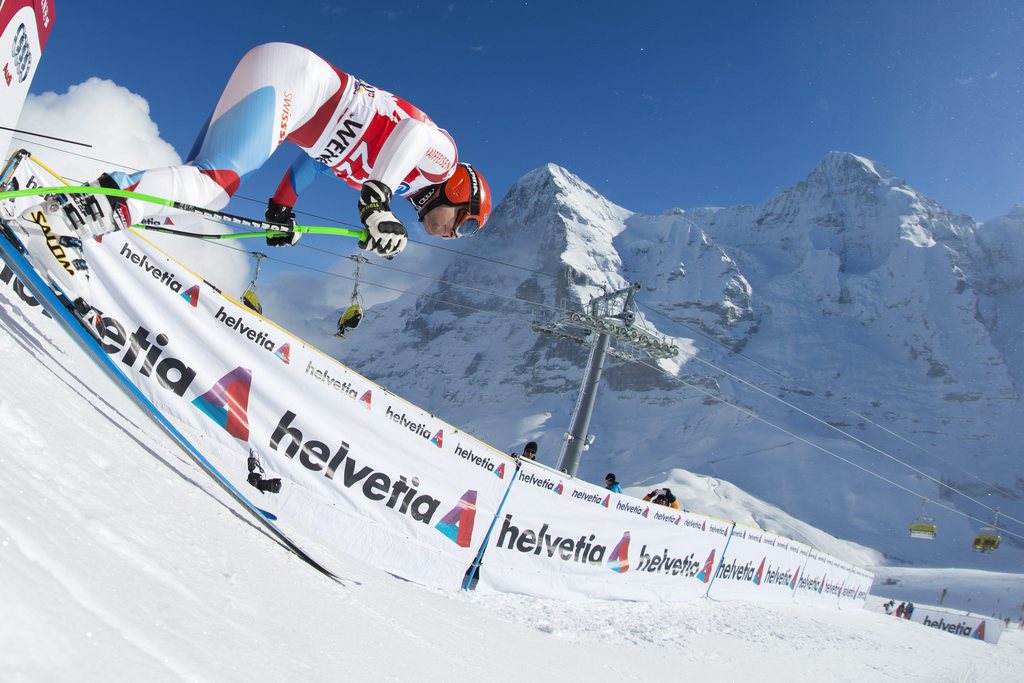How a village profits from a giant downhill ski race

The Lauberhorn, the oldest and longest race on the FIS Ski World Cup circuit, puts the Swiss resort of Wengen on the world stage once a year. Could the village survive without it?
“Lauberhorn External linkis why Wengen External linkis so famous and why so many tourists come year-round,” says hotelier Bettina Zinnert, noting that it’s a sure-fire attraction for all Swiss visitors who envision skiing the Lauberhorn race course at least once in a lifetime.
At the Hotel Schönegg, manager Caroline Ogi calls the Lauberhorn race coverage “perfect publicity – especially in good weather”.
Another person with a clear interest in the attention garnered by the race is Rachel Padley, who runs an apartment rental service in the ski resort: “Lauberhorn gets the word out about Wengen. It is a great way of publicising the town to the world.”
But without the race, it’s not just Wengen that would suffer. “It’s the most important event for this entire region,” says Marc Ungerer, CEO of the region’s tourist board, Jungfrau Tourism. Ungerer notes that the Lauberhorn gives Wengen the cache of being one of the strongest players in the skiing industry. “No one can say what it would mean without it.”
Each year in mid-January, the worldwide media coverage that puts the spotlight on Wengen for an entire weekend provides the biggest commercial stimulus. “The TV coverage we get, we could never finance,” says Rolf Wegmüller, director of Wengen Tourism.
On Swiss TV alone, the Lauberhorn consistently attracts the largest audience – more than one million viewers – for a sports event taking place in Switzerland. It’s also broadcast live in Austria, with extended coverage in Germany, Italy, France and the United Kingdom. Asian media attention is also sprouting. This year Chinese TV is covering the race – a first – sparked by interest in downhill racers competing from Japan and for the first time, from Korea.
Pinpointing value
The Lauberhorn staff estimate the annual value for the Jungfrau region at CHF30 million ($30.6 million), which includes direct as well as indirect benefits, such as worldwide media coverage. The figure is based on a study conducted by the Institute of Tourism Economics at the Lucerne University of Applied Sciences and Arts, which goes back to 2002.
Take out those indirect benefits, and the number shrinks considerably, says Lauberhorn CEO Markus Lehmann. He believes the estimated annual net gain for Wengen and the region is CHF8 million in direct benefits. Still, that’s roughly CHF3 million higher than it was three years ago.
Under that vast umbrella are myriad examples of benefits. Many of Wengen’s infrastructure innovations for skiing are credited to the Lauberhorn, including the first artificial snowmaker in the Jungfrau ski region and the fuel-efficient GPS System for grooming the slopes, an environmentally-friendly bonus.
The races (January 12-14, 2018)
Friday: Alpine Combined Downhill and Combined Slalom
Saturday: Downhill
Sunday: Slalom
Key partners helping to provide financial support include the powerful and profitable Jungfrau RailwaysExternal link, which operate all of the railways and ski lifts in the region. The firm sponsors the race to the tune of CHF500,000 and doesn’t charge for transport assistance directly related to the race. According to CEO Urs Kessler, the Lauberhorn is the biggest event on company’s annual calendar.
Jungfrau Railway money spent on the race presumably benefits the company through future ticket sales, which include transporting some 35,000 spectators to the scene. And the firm regards the worldwide broadcasting of the race as “important value for winter sports in the Jungfrau region”, according to Kessler.
But the Jungfrau Railway Group, cites other benefits accruing from this year on. Its new restaurant adjacent to the Kleine Scheidegg station near the top of the Lauberhorn slope, Kleine expects to serve more than 1,000 meals during the race weekend, an increase in revenue of up to 40%.
Restaurant manager Jean-Daniel Bingisser also expects to reap benefits from advertising, such as patrons posting foodie photos to Facebook, Twitter and Instagram, and from the Swiss national tourist board’s publicising of the event.
It’s a mixed blessing for Wengen hotels. On the one hand, they provide 1,400 subsidised beds for some two dozen national teams and scores of journalists and sponsors. “It covers half the cost,” says Bettina Zinnert, whose family owns three hotels in the resort. Still, she says Lauberhorn brings free media coverage. “We couldn’t pay for that advertising.”
Other partners and sponsors refuse to disclose their financial investments, choosing only to stress the benefits. Swiss International Airlines notes that Lauberhorn strengthens its market positioning focused on Swiss quality and hospitality, while Swisscom and Swiss-Ski share a common goal: to keep Switzerland at the top of international ski sports for the long haul.

Lauberhorn’s backstage muscle
The International Lauberhorn Ski Race office, effectively its “ground zero”, is located in the Wengen Tourism Chalet just along the main street. It’s here, on the second floor, where a staff of four – two of them part-time – work throughout the year preparing for three days of racing and all the fanfare that goes with it. When winter comes, they add two more staffers for logistics. Their annual Lauberhorn budget: CHF6.8 million.
During the Lauberhorn weekend, staffing grows exponentially. At maximum strength on race days, some 1,800 workers – most of them volunteers – are on hand to make the race an exciting spectacle that fans have come to expect year after year.
But weeks before that, hundreds of hours go into race preparation. Along the 4.5 km race slope, several full-time workers, paid by Lauberhorn, are assigned to produce artificial snow and help groom the slope, not just for the race, but also for the public who are allowed to ski the course up until December 29.
Three hundred Swiss Army and Civil Defence personnel, along with 200 volunteers, also pour into Wengen to prepare the course and construct spectator stands and other infrastructure along the route and in the town centre. That includes converting the local ice rink into an arena with food stalls.
Over the Christmas holiday break, soldiers, dressed in camouflage fatigues, are either on top of scaffolding or skiing swiftly down the slopes, often with their arms full of red pole markers.
Meanwhile, their Civil Defence colleagues, wearing matching neon orange suits, huddle before dawn near the train station to receive the day’s marching orders from team leaders.
This year the 500-man team struggled with the monumental task of quickly rebuilding several VIP tents damaged by a severe storm only a couple days before the first race day. Howling winds of up to 200 kilometres per hour wreaked havoc on power lines and infrastructure, forcing Lauberhorn officials to fly out the old equipment and replace it with new.
The event stokes both community and personal pride. Virtually all echo something similar to Roland Marty, Wengen’s train station chief who has worked during the race for 38 years: “For us, for the whole region, these are the most important days of year, these three.”
From his perch behind the glassed-in counter inside the station, Marty said the train routine runs like clockwork every year. The busiest times are Saturday from 9am to 1pm carrying crowds up the mountain, and from 4pm to midnight taking them down.

In compliance with the JTI standards
More: SWI swissinfo.ch certified by the Journalism Trust Initiative


You can find an overview of ongoing debates with our journalists here . Please join us!
If you want to start a conversation about a topic raised in this article or want to report factual errors, email us at english@swissinfo.ch.